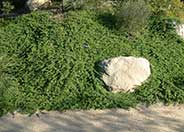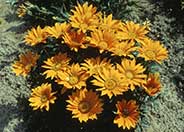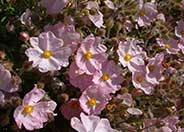
Common name:Blue Blossom Ceanothus
Botanical name:Ceanothus thyrsiflorus 'Skylark'
The blue blossom ceanothus is a shrub that has dark blue flower clusters that bloom profusely. This smaller growing selection grows to 6' high and 4'-6' wide. This shrub attracts butterflies, hummingbirds and beneficial insects. Its native counterpart can be found from sea level to 1500' elevations in mixed evergreen and redwood forests of the Coast Ranges.

Common name:Ground Cover Myoporum
Botanical name:Myoporum parvifolium
This great ground cover will grow 9" high and 9' wide and does well in partial or full sun with moderate watering. It produces delicate white flowers that bloom in summer and are surrounded by tiny, bright green leaves.

Common name:Hybrid Gazanias
Botanical name:Gazania hybrids
These ground covers will grow less than 1' tall and have medium size, gray green leaves with gold, lavender, orange, red, yellow, or white flowers that are present all year.

Common name:Pink Coral Rockrose
Botanical name:Cistus X skanbergii
This Rockrose is a bushy evergreen shrub 2'-4' high and 5' across with narrow, gray green leaves and complimentary clear pink flowers. Flowers appear in great profusion in mid-spring and can continue well into summer. It is more refined in character than most other rockroses, and well-suited to smaller gardens.
Maintenance Tips
Cistus X skanbergii is a compact, woody shrub from Mediterranean regions that grows 2-4’ tall and up to 5’ wide. The plant becomes covered with masses of pink flowers in the late spring. This is one of the easiest plants to keep in a California garden. It will do best planted in full sun and well-drained soil and planted in a location where it can reach its full size. This plant rarely has any pest and disease issues and no need for fertilizer. In mild climates, this plant can send out a later season blooming cycle if the weather in the fall is similar to the spring. The best way to encourage the second blooming cycle is to prune back the shrub by about a third in later summer.
Photographer: GardenSoft
Practice grass-cycling by leaving short grass clippings on lawns after mowing, so that nutrients and organic matter are returned to the soil.
Adjust sprinklers to avoid watering sidewalks and driveways.
Drip and other smart irrigation delivers water directly to roots, allowing no excess water for weeds.